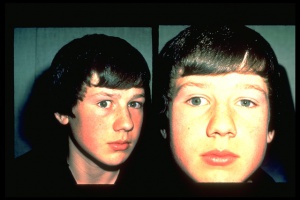Ocular Torticollis
All content on Eyewiki is protected by copyright law and the Terms of Service. This content may not be reproduced, copied, or put into any artificial intelligence program, including large language and generative AI models, without permission from the Academy.

Ocular torticollis is defined by abnormal head posture as a compensatory mechanism for an ocular abnormality.
Overview

Ocular torticollis is an abnormal head posture adopted in order to optimize vision and/or maintain binocularity. The incidence is approximately 3% in a pediatric ophthalmology practice.[1]It may consist of any combination of head tilt, face turn, chin elevation or chin depression.[2] While ocular torticollis may occur at any age, it typically manifests early in life and becomes more pronounced over time as the visual system matures.[3]
Etiology
In general, the etiology of torticollis may be ocular, neurologic or orthopedic. When due to an ocular cause, the head position occurs to compensate for an ocular condition. This may include a condition such as infantile nystagmus syndrome to improve the vision or incomitant strabismus to improve binocularity. The chart below details possible ocular and non-ocular etiologies.
Differential Diagnosis[2][4]
Ocular Torticollis
- Attempt to improve visual resolution
- Nystagmus
- Infantile nystagmus syndrome (congenital motor or sensory nystagmus; null point)
- Fusion maldevelopment nystagmus syndrome (manifest latent nystagmus; less in adduction)
- Periodic alternative nystagmus (alternating null point)
- Spasmus nutans
- Acquired adult jerk nystagmus
- Ptosis
- Monocular blindness (with fusion maldevelopment nystagmus syndrome, or for centration of remaining field)
- Refractive error
- Homonymous hemianopia
- Nystagmus
- Motility Disorders
- A- or V- pattern esotropia or exotropia
- Paretic strabismus
- Superior oblique palsy
- Duane retraction syndrome
- Sixth nerve palsy
- Third nerve palsy
- Inferior oblique palsy
- Restrictive strabismus
- Brown syndrome
- Thyroid eye disease
- Orbital fracture
- Congenital fibrosis of extraocular muscles
- Supranuclear disorders
- Monocular elevation deficiency
- Dorsal midbrain syndrome
- Gaze palsy
- Dissociated vertical deviation
- Ocular tilt reaction
Non-ocular Torticollis
- Orthopedic
- Congenital muscular torticollis
- Trauma
- Inflammatory myositis
- Skeletal abnormalities (such as Klippel-Feil syndrome, plagiocephaly, cervical spine subluxation, occipito-cervical stenosis)
- Fibrotic shortening of the sternocleidomastoid muscle
- Neurologic
- Syringomyelia
- Dystonia
- Deafness in one ear
- Psychiatric disturbance
- Orthopedic
Diagnosis
Ocular torticollis is diagnosed primarily by history and clinical exam. Diagnostic evaluation may include measuring the abnormal head position, evaluating extraocular motility and alignment with particular attention to gaze positions opposite to those favored, external examination for nystagmus and ptosis, and retinoscopy to assess refractive error with particular attention to oblique axis astigmatism. Subtle nystagmus may be visible only during slit-lamp or fundus examination.[4] A dilated fundus examination may also be helpful for evaluating torsional misalignment. Hess-Lancaster or a Lee screen may be used to asses for antagonist muscle contracture. Stereoscopic tests and prisms to test for motor fusion may also be used. The Bielschowsky three step test can be performed to diagnose superior oblique palsy. The alternate occlusion test can identify an ocular muscle imbalance by eye occlusion.[5]
Epidemiology
A 2-year prospective study of abnormal head postures with ocular etiologies was analyzed by Kushner in 1979 and identified incomitance as the leading cause of ocular torticollis.[6] Mitchel et al. confirmed incomitance as the leading cause with an expanded prospective study published in 1999.[2]
The Kushner study identified eight basic mechanisms causing ocular torticollis in a study group of 188 patients from an academic center. Out of the 188 cases, 118 (62.7%) were related to incomitance, 38 (20.2%) were due to nystagmus, 12 (6.3%) due to congenital esotropia with ocular posture, 10 (5.3%) due to permitting foveal fixation, 4 (2.1%) with cosmetic etiology, 3 (1.6%) due to ocular motor apraxia, 2 (1%) with spasmus nutans, and 1 (0.5%) with astigmatism.[6]
Mitchel studied a group of 630 patients from a private ophthalmology practice and analyzed the etiologies of ocular torticollis; he further differentiated ocular torticollis secondary to incomitance into specific causes. Out of the 630 cases of ocular torticollis, 330 (52.4%) were related to incomitance, 120 (19%) were due to nystagmus, 69 (10.9%) due to congenital esotropia with ocular posture, 27 (4.3%) due to permitting foveal fixation, 2 (0.3%) due to spasmus nutans, 57 (9%) without an identified etiology, and 25 (4%) associated with medical or neurologic conditions. Among the 330 cases of ocular torticollis related to incomitance, 116 (35.2%) were due to A/V pattern horizontal incomitance, 59 (17.9%) were due to superior oblique palsy, 48 (14.5%) were due to horizontal incomitance from asymmetric surgery, 46 (13.9%) were due to Duane syndrome, 25 (7.6%) were due to Brown syndrome, 9 (2.7%) were due to double elevator palsy, 6 (1.5%) were due to inferior oblique palsy, 4 (1.2%) were due to torsional incomitance, 1 (0.3%) was due to sixth nerve palsy, 1 (0.3%) was due to third nerve palsy, and 1 (0.3%) was due to superior rectus palsy.[2]
Management
Management is directed towards treating the etiology of ocular torticollis. In the setting of an incomitant strabismus, the strategy is to surgically correct the eye misalignment to primary position in order to increase the field of binocular fusion and decrease the face turn. In patients with normal or minimally limited extraocular motility, surgery is typically performed on both eyes. If there is significant unilateral oculomotor restriction or palsy, the face turn may be corrected by moving the eye with limited motility into primary position.[7] In the setting of nystagmus, the strategy is to identify the fixating eye and null point as these two components determine the magnitude of face turn. Surgery then involves moving the null point of the fixating eye to the primary position, and then correcting any residual or induced strabismus by repositioning the non-fixating eye.[7] Early diagnosis and correction of underlying ocular etiology of torticollis is important to prevent development of musculoskeletal changes such as neck and facial asymmetry.[4]
References
- ↑ Boricean ID, Bărar A. Understanding ocular torticollis in children. Oftalmologia. 2011;55(1):10-26.
- ↑ Jump up to: 2.0 2.1 2.2 2.3 Mitchell PR. Ocular torticollis. Trans Am Ophthalmol Soc. 97, 697–769 (1999).
- ↑ Yoon JA, Choi H, Shin YB, Jeon H. Development of a questionnaire to identify ocular torticollis. Eur J Pediatr. 2021 Feb;180(2):561-567.
- ↑ Jump up to: 4.0 4.1 4.2 American Academy of Ophthalmology. “Torticollis: Differential Diagnosis and Evaluation.” Basic and Clinical Science Course: 2020-2021, 83 (2020).
- ↑ Cite error: Invalid
<ref>tag; no text was provided for refs named:2 - ↑ Jump up to: 6.0 6.1 Kushner BJ. Ocular causes of abnormal head postures. Ophthalmology. 86(12), 2115-25 (1979).
- ↑ Jump up to: 7.0 7.1 Cite error: Invalid
<ref>tag; no text was provided for refs named:1

